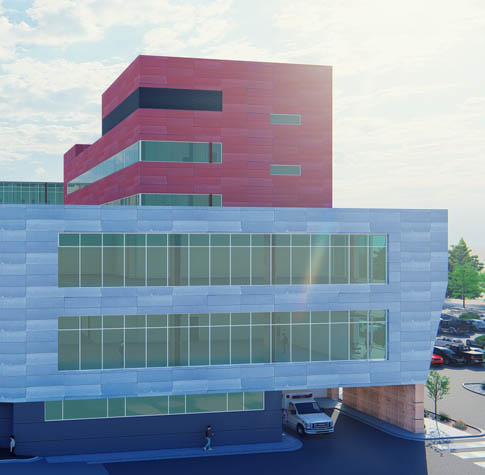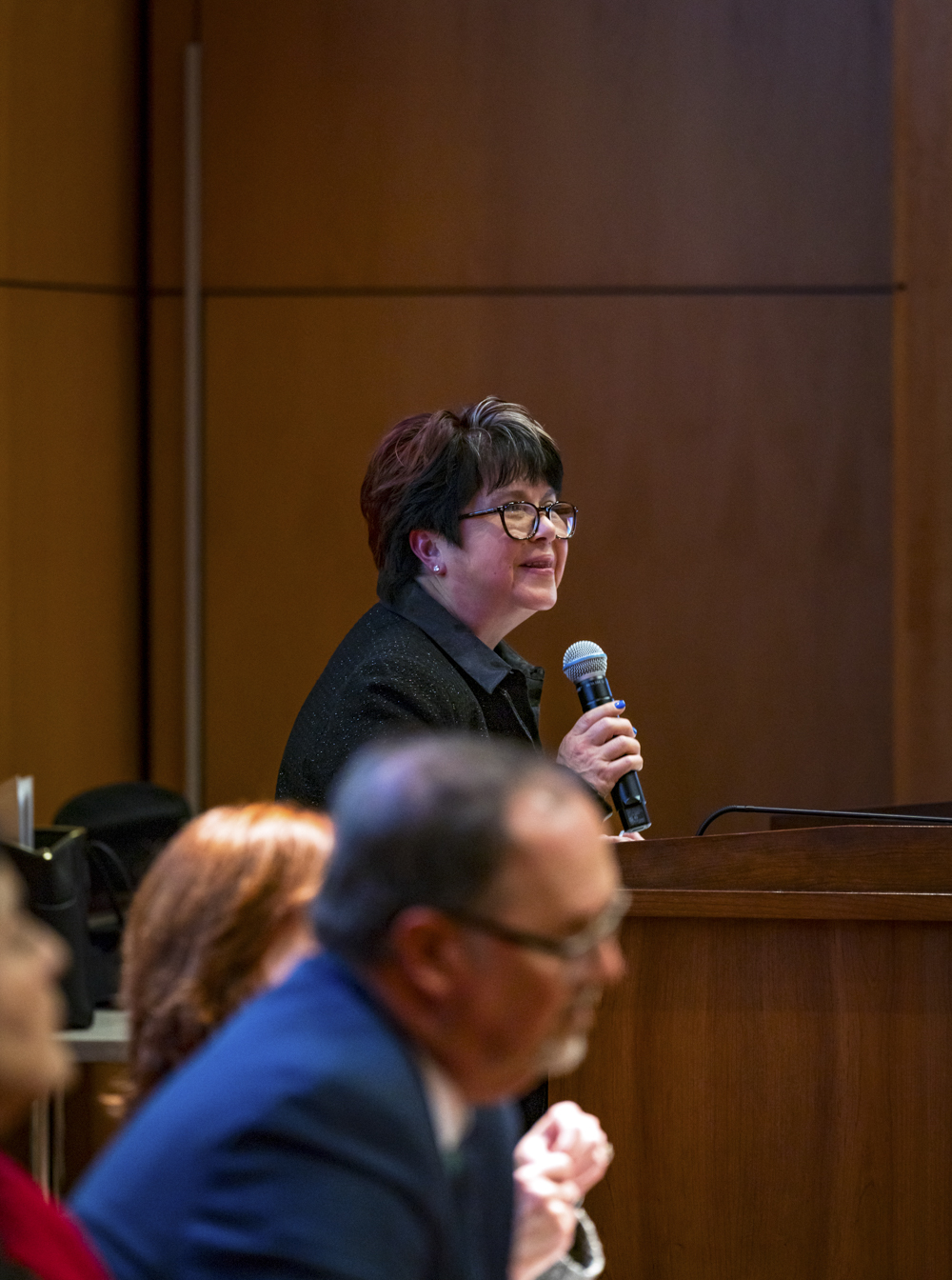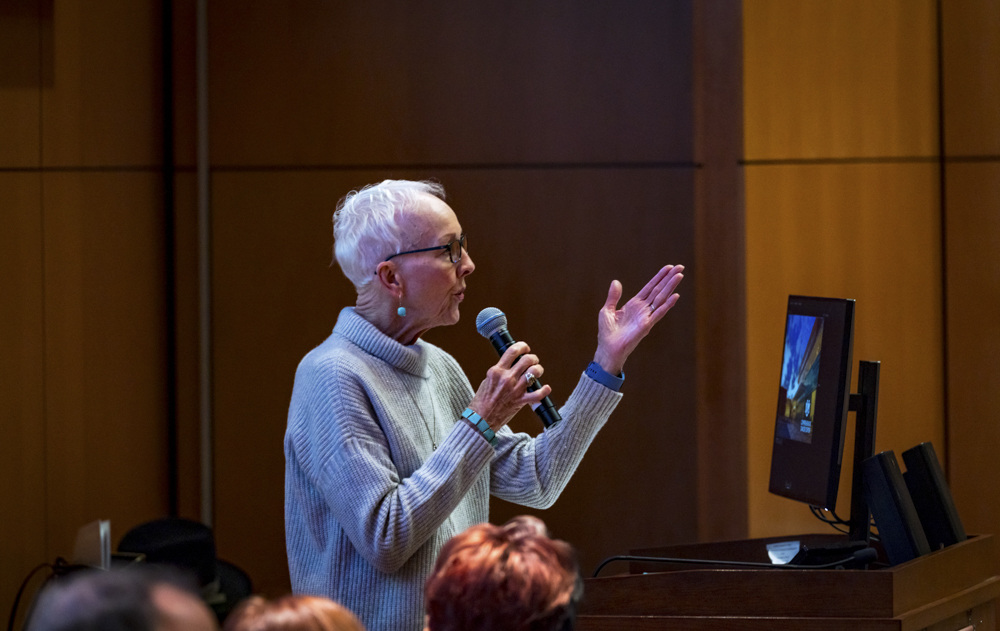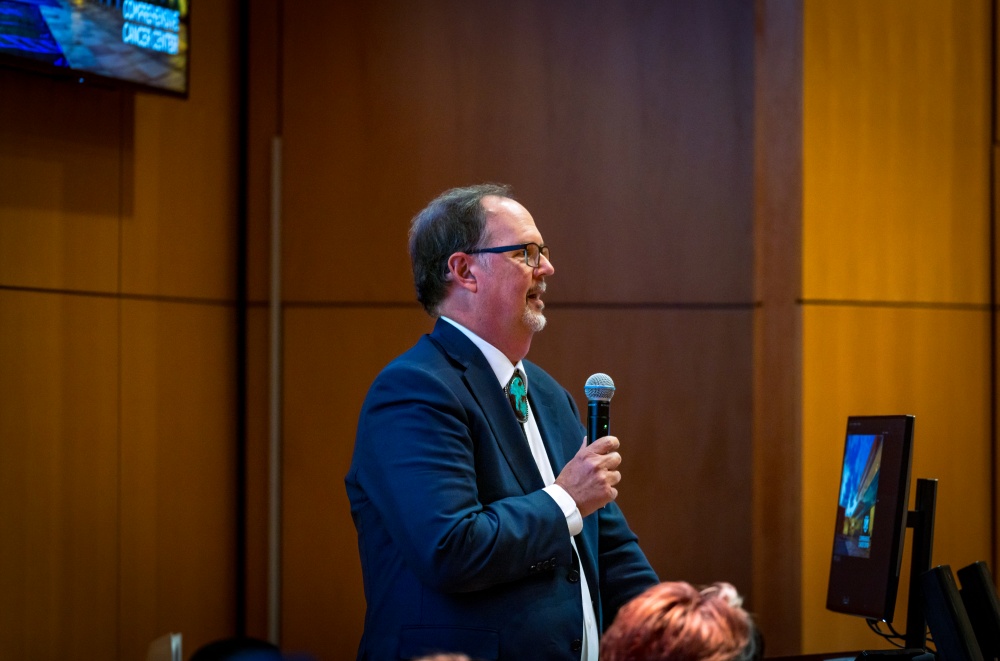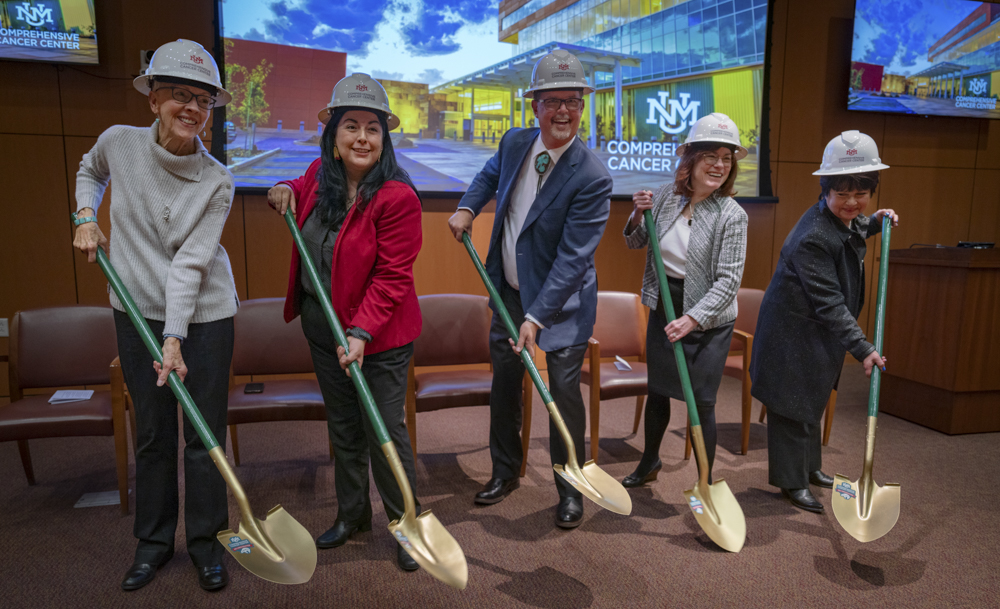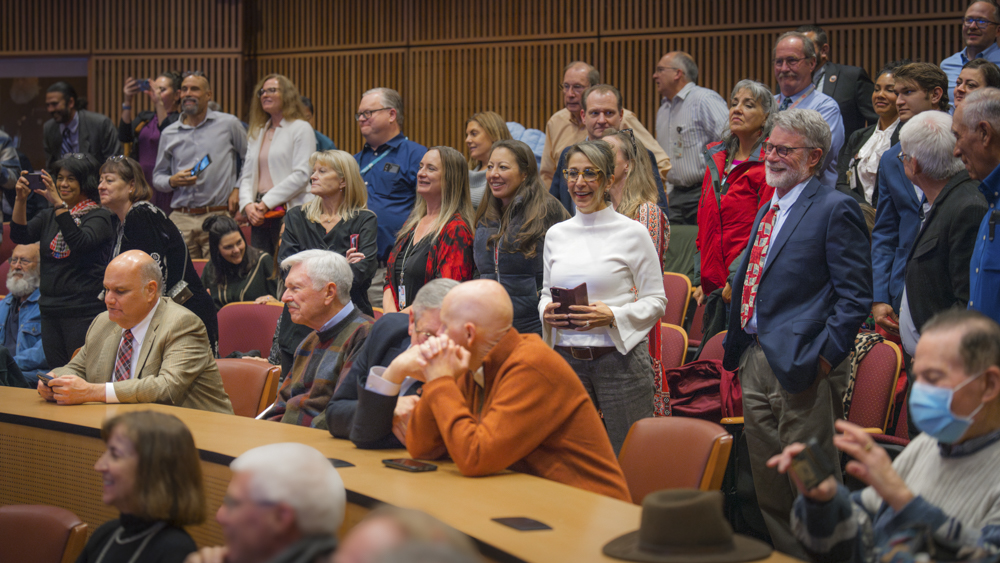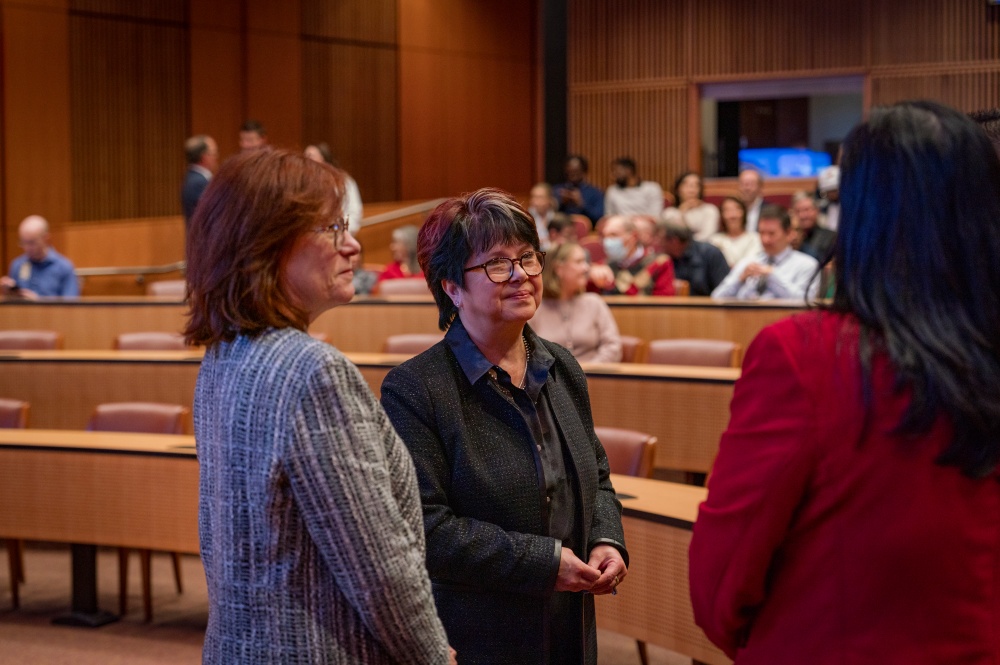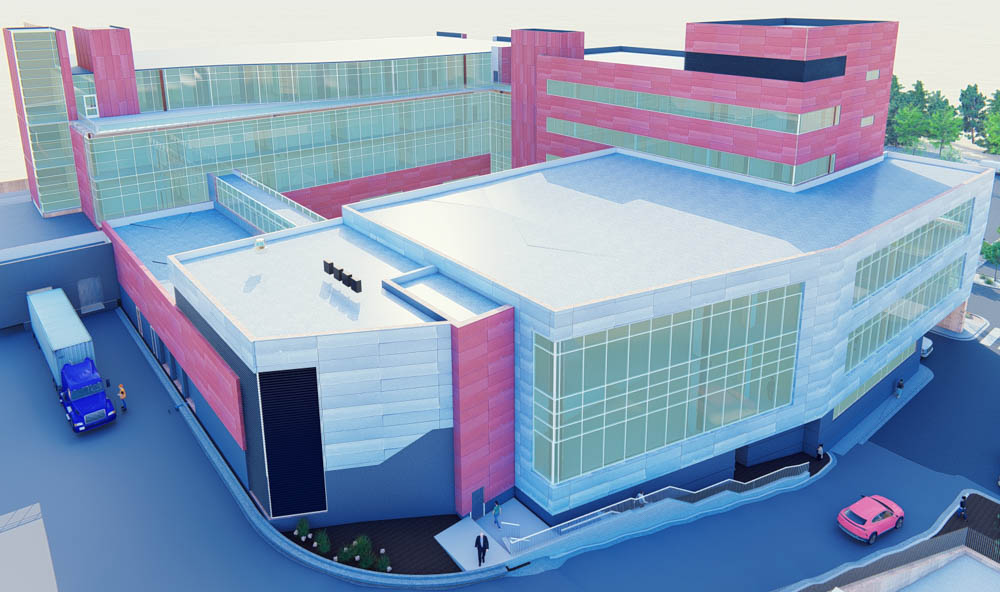The University of New Mexico Comprehensive Cancer Center is expanding its clinical space to offer treatments that no other entity in the state can offer.
The existing clinic building comprises more than 200,000 square feet of exam rooms, outpatient surgical suites, radiation vaults, a bone marrow and stem cell transplant bay, and a chemotherapy infusion suite. The building was opened in 2009, and some areas were finished in 2017.
Now, even more space is needed.
The facility expansion will make room for advanced radiation treatment machines, theranostic treatment rooms, interventional radiology procedures, and cellular therapies that include allogeneic stem cell transplantation and chimeric antigen receptor therapy (CAR T).
The new build-out was initially approved for $28 million in 2018, but plans were put on hold because of the COVID pandemic. In the intervening time, construction costs rose: the project now costs $61 million.
The bulk of the funding is coming from bond financing through the New Mexico Finance Authority and from New Mexico State Legislature appropriations. The UNM Health Sciences Center is also providing some funds.
“Due to our budgetary challenges, we broke the project into three segments,” says Rodney Martinez, Chief Financial Officer of the UNM Comprehensive Cancer Center. “And we prioritized those segments by patient needs.”
Summary
- The UNM Comprehensive Cancer Center will expand its clinic space to meet patient needs by offering unique treatments that are not offered elsewhere in New Mexico.
- The project must be broken into segments to address budgetary challenges.
- The segments have been prioritized by patient needs.
- Radiation oncology, theranostics and cellular therapy programs to expand; interventional radiology program to be added.
- A groundbreaking event is planned for Dec. 14 at 4:30 pm. Members of the news media are requested to confirm attendance.
Segment 1: Out with the Old, In with the New
In the first stage, which has been completed, the Accuray Tomotherapy machine was replaced with an Elekta Versa HD.
The Tomotherapy machine was installed in 2008 and was the first tomotherapy machine in New Mexico. It was so large that it had to be dismantled and removed in pieces.
The newly-installed Versa HD can be used to perform intensity modulated radiation therapy, stereotactic body radiation therapy and stereotactic radiosurgery for a wide variety of tumor types. The new machine is also more reliable and easier to maintain, Martinez says. It was made available for patients in December.
Stereotactic body radiation therapy is a noninvasive procedure that delivers high dose radiation to a tumor but a much lower dose to surrounding tissues, thus killing tumor cells but sparing the nearby cells. During treatment, the patient lies on a table, and the head of the machine, called the gantry, rotates around the patient.
The gantry focuses radiation beams into the patient’s tumor from different directions. All the beams pass through the tumor, so radiation concentrates there and kills the tumor cells. Lower doses reach the surrounding cells, and they survive.
The radiation beams can be precisely aimed to target small or irregular tumors, and the ability to deliver large doses to the tumor cells safely and accurately has increased the cure rate of this treatment while reducing the number of treatment days.
Killing cells by concentrating radiation on them can also be used to perform surgery. Called stereotactic radiosurgery, the procedure is used to perform radiosurgery in places that are difficult for a surgeon to reach or in situations in which surgery poses a high risk.
Stereotactic radiosurgery is a noninvasive procedure; the skin is not cut. The treatment delivers high dose radiation to specific targets in the brain.
“It can be used to treat both brain metastasis as well as benign brain lesions such as meningioma,” says David Lee, MD, PhD, director of Radiation Oncology at UNM Cancer Center. “Stereotactic radiosurgery is usually performed in a single treatment but can sometimes require up to five treatments.”
“The Versa HD is state-of-the-art and will provide modern methods and treatments for our patients,” Martinez says.
Martinez explains further that about 95 people per day require radiation oncology treatments, but currently, the UNM Cancer Center has the capacity to treat only 75 people per day.
The Versa HD will keep wait times acceptable for patients, Martinez says, but it won’t add capacity. The UNM Cancer Center needs another machine for radiation oncology.
Segment 2: New Machines and Space for Unique Treatments
The second segment of the expansion project includes a new, state-of-the-art magnetic resonance linear accelerator (MRI LINAC) to increase radiation oncology capacity and five new infusion suites for the theranostics program.
“This capability will be available only at the UNM Cancer Center,” Martinez says of the MRI LINAC. “No other facility in our state can offer a machine that can image a tumor in real time while delivering radiation.”
The MRI LINAC will require a new vault in the radiation oncology area. The vault walls are 6 feet thick and made of concrete to prevent radiation from escaping. Once completed, the new machine will be installed and commissioned before any patients can be scheduled for treatment.
The MRI LINAC simultaneously images a tumor while focusing radiation beams on it. It can more precisely target a tumor because it uses magnetic resonance imaging (MRI) which allows doctors to see the tumor better. Doctors can then use adaptive radiotherapy to adjust the radiation beams to stay on the tumor while the patient breathes.
“MRI-LINAC will give us unprecedented ability to treat tumors that are hard to see, such as pancreatic cancers and liver cancers,” says Lee. “The result will be better targeting of tumors with less side effects. This is an incredible opportunity for the patients of New Mexico.”
The MRI LINAC is expected to be available for patients in 2025.
The UNM Cancer Center is the only cancer center in the state to be able to offer theranostic treatments as part of a multidisciplinary approach to care.
The theranostics program started in 2018 with the Lutathera program. Currently, the UNM Cancer Center is the only facility in the state that offers theranostic treatment — also called peptide receptor radionuclide therapy, or PRRT — for neuroendocrine tumors.
Theranostics, derived from the words therapy and diagnostic, uses a two-part drug molecule in a two-step procedure. One part of the drug molecule binds to certain receptors on cancer cells; the other part is a radioactive ion.
In the first step of the treatment, the imaging step, the two-part drug molecule is injected into the patient’s bloodstream. The part that binds to receptors on cancer cells is attached to a radioactive ion that gives off low-energy radioactive particles. These particles illuminate the cancer cells during Positron Emission Tomography (PET) scans, enabling doctors to diagnose and measure the cancer.
In the second step, the treatment is given in a series of injections. Again, a two-part molecule is used. The part that binds to cancer cells’ receptors is the same as in the first step. But the other part is a different radioactive atom that emits high-energy radiation.
The high-energy radiation destroys cancer cells but doesn’t travel far within the body. Only a small number of nearby cells are affected. This type of treatment can precisely kill cancer cells but leaves the surrounding healthy tissues with little damage.
Lutathera® is a theranostic treatment for advanced neuroendocrine tumors, a rare form of cancer. It was approved by the US Food and Drug Administration in 2018. Bernard Tawfik, MD, leads the Lutathera program at UNM Cancer Center.
In 2022, the FDA approved Pluvicto™ as a new theranostic treatment for metastatic prostate cancer. Neda Hashemi, MD, leads the Pluvicto program and the Prostate, Testicular, Kidney and Bladder Cancers team at UNM Cancer Center.
The Center currently has the capacity to offer two treatments (injections) per week. The new infusion suites will expand the theranostic program to offer as many as 25 treatments per week.
Segment 3: Investments in Cellular Therapies and Interventional Radiology
The last segment of the project will include an 11,000 square foot interventional radiology space and a 4,000 square foot cellular Good Manufacturing Practice (cGMP) laboratory for cell processing for the UNM Cancer Center’s Bone Marrow and Stem Cell Transplantation program.
In the past, New Mexico has lacked an accredited and certified bone marrow and stem cell transplantation program, Martinez says. New Mexicans with cancers of the blood and bone marrow and other diseases have had to travel out of state for long periods for expensive, life-disrupting care.
The cGMP laboratory will support the UNM Cancer Center’s bone marrow and stem cell transplant program, which offers autologous stem cell transplants, and more recently, allogeneic stem cell transplants for people with certain types of blood cancers.
The UNM Cancer Center has achieved accreditation from the Foundation for the Accreditation of Cellular Therapy for autologous transplantation.
In autologous stem cell transplants, a patient’s own stem cells are harvested from the bloodstream and frozen. The patient is then given strong chemotherapy to rid the body of cancer. Once the chemotherapy is completed, the stem cells are injected back into the patient’s bloodstream where they find their way back to the bone marrow and replenish the patient’s supply of blood cells.
In allogeneic stem cell transplants, the stem cells are harvested from a donor. The stem cells must be matched on tens of different factors to reduce the risk of the patient’s body rejecting the donor’s cells.
Both types of stem cell transplantation need to safely store and defrost the stem cells.
The UNM Cancer Center also plans to provide chimeric antigen receptor therapy (CAR-T) for a spectrum of hematologic malignancies. CAR T and other cellular therapies need additional laboratory features, such as long-term cell storage and the ability to safely process, sequence and manipulate stem cells and immune cells.
CAR T offers new ways to enhance the immune system to treat lymphomas, myelomas and leukemias that have failed to respond to more traditional therapy. Instead of stem cells, white blood cells are collected from the patient.
These white blood cells are sent to an outside lab, where they are modified. The modified white blood cells have receptors on their surfaces that are not otherwise present on these white blood cells. These receptors are tuned to find cancer cells and destroy them until they are all gone.
Patients experience side effects from CAR T and must stay close to the hospital for some weeks after treatment.
"CAR-T therapies have been shown to be transformational for some blood cancers,” says Yolanda Sanchez, PhD, Director and CEO of the UNM Cancer Center. “And being able to receive CAR T therapy in Albuquerque means patients can stay close to their loved ones in New Mexico during a difficult time in their lives.”
The funds for this segment of the project are still in review, but Martinez is optimistic that they will be approved.
UNM Comprehensive Cancer Center
The University of New Mexico Comprehensive Cancer Center is the Official Cancer Center of New Mexico and the only National Cancer Institute-designated Cancer Center in a 500-mile radius.
Its more than 136 board-certified oncology specialty physicians include cancer surgeons in every specialty (abdominal, thoracic, bone and soft tissue, neurosurgery, genitourinary, gynecology, and head and neck cancers), adult and pediatric hematologists/medical oncologists, gynecologic oncologists, and radiation oncologists. They, along with more than 600 other cancer healthcare professionals (nurses, pharmacists, nutritionists, navigators, psychologists and social workers), provide treatment to 65% of New Mexico’s cancer patients from all across the state and partner with community health systems statewide to provide cancer care closer to home. They treated almost 15,000 patients in more than 100,000 ambulatory clinic visits in addition to in-patient hospitalizations at UNM Hospital.
A total of nearly 1,855 patients participated in cancer clinical trials testing new cancer treatments that include tests of novel cancer prevention strategies and cancer genome sequencing.
The more than 123 cancer research scientists affiliated with the UNMCCC were awarded $38.2 million in federal and private grants and contracts for cancer research projects. Since 2015, they have published nearly 1000 manuscripts, and promoting economic development, they filed 136 new patents and launched 10 new biotechnology start-up companies.
Finally, the physicians, scientists and staff have provided education and training experiences to more than 500 high school, undergraduate, graduate, and postdoctoral fellowship students in cancer research and cancer health care delivery.
